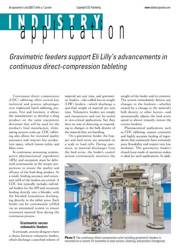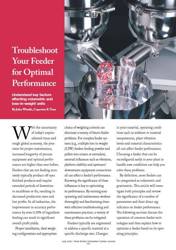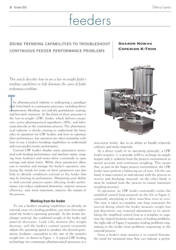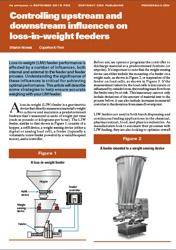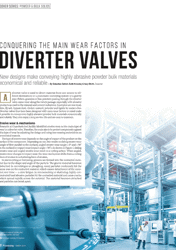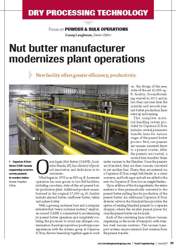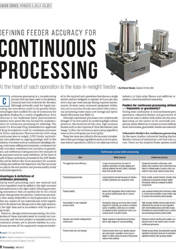Continuous direct compression (CDC) tableting offers several key technical and process advantages over traditional batch tableting processes. First and foremost, it allows the manufacturer to develop a drug product on the same equipment drivetrain that will be used for the product's final manufacture, eliminating process scale-up. CDC tableting also allows for increased quality assurance and requires less production space, which lowers utility and labor costs.
Publications
Showing all publications
-
Gravimetric feeders support Eli Lilly's advancements in continuous direct-compression tableting
Tablets & Capsules
-
Troubleshoot Your Feeder Performance
Bulk Solids Innovation Center Journal
With the uncertainty of today’s unprecedented times and tough global economy, the pressures for proper maintenance, increased longevity of process equipment and optimal performance are higher than ever before. Feeders that are not feeding accurately typically produce off-spec finished products and require extended periods of downtime to recalibrate or fix, resulting in decreased production rates and lost profits. Understand key factors affecting volumetric and loss-in-weight units.
-
Is Your Feeding Technology Robust Enough?
Plastics Technology
Today’s modern manufacturing processes utilize loss-in-weight (LIW) feeders as the automated dispensing technology for dry bulk solids. The most current feeding technologies have evolved in many aspects through improved control and design features with an emphasis on process robustness and intelligence. It is expected that feeder controls can easily connect to industrial networks and key process data, which has become a critical criterion in evaluating not only feeder performance but also real-time indication of the complete process. This article will address what a processor should consider when evaluating his current feeding equipment and the feeder’s ability to monitor, trend and react to process variations.
-
Production industrie alimentaire : Attention au dosage (in French)
Infovrac N°225 - Mars 2020
La fabrication de n'importe quel mélange de produits alimentaires implique généralement les étapes intermédiaires de procédé de transfert et de dosage continu ou par lot des ingrédients en calculant leur pourcentage en poids dans un mélange. En fonction de ce pourcentage, les matière sont divisées en catégories : majeures, mineures et micros. Que peut-on faire pour améliorer le fonctionnement des systèmes de dosage par lots?
-

Chemical Processing E-Handbook: Succeed with Solids
Chemical Processing
In our article about solids processes from Mike Plant, Coperion K-Tron UK, you can read more about our smart feeders that enhance detergent-making process - New facility benefits from process controls and equipment that optimize production.
Download the ebook here
-
Using Trending Capabilities to Troubleshoot Continuous Feeder Performance Problems
Tablets & Capsules
Learn how to use a loss-in-weight feeder's trending capabilities to help determine the cause of feeder performance problems.
-
Controlling upstream and downstream influences on loss-in-weight feeders
Powder Bulk Engineering
Loss-in-weight (LIW) feeder performance is affected by a number of influences, both internal and external to the feeder and feeder process. Understanding the significance of these influences is critical for achieving optimal performance. This article will describe some strategies to help ensure accurate weighinhg with your LIW feeder.
-
Conquering the Main Wear Factors in Diverter Valves
Powder & Bulk Solids
A diverter valve is used to divert material from one source to different destinations in a pneumatic conveying system or a gravity pipe. Pellets, granules or fine powders passing through the diverter valve cause wear along the valve's passage, especially with abrasive products as used in the mineral and cement industries. Examples are raw meal, lime, fly ash, bypass dust, clinker, cement, petcoke and lignite to name a few. Diverter valves that have been designed with main wear factors in mind make it possible to convey even highly abrasive powder bulk materials economically and reliably. They also enjoy a long service life and are easy to maintain.
-
Nut Butter Manufacturer Modernizes Plant Operations
Food Engineering
The complete material handling system provided by Coperion K-Tron includes several pneumatic transfer lines for various stages of the peanut butter process. First, raw peanuts are vacuum conveyed direct to a peanut roaster. After the peanuts are roasted, a second line transfers them under vacuum to the blancher. Once the peanuts are blanched, they are then vacuum conveyed to yet another line. There, they are metered via a Coperion K-Tron weigh belt feeder to a screw conveyor, and both sugar and salt are added to the nuts via Coperion K-Tron loss-in-weight feeders.
-
Defining Feeder Accuracy For Continuous Processing
Processing Magazine
Continuous processing is a manufacturing practice that has been used in the plastics, chemical and food industries for decades. Although primarily used for liquid processing, the innovations made in dry powder feeder technologies have enabled the use of continuous dry ingredient feeding for a variety of applications.
